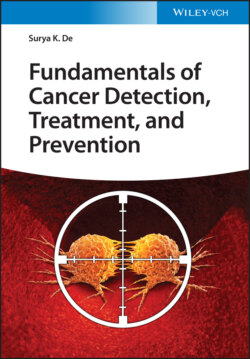Читать книгу Fundamentals of Cancer Detection, Treatment, and Prevention - Surya K. De - Страница 24
1.5 The Role of Genes and Chromosomes
ОглавлениеIn the nucleus of each cell, there are the thread‐like structures that package deoxyribonucleic acid (DNA) called chromosomes. Chromosomes are found in all living cells and consist of a single molecule of DNA bound to various proteins (Figure 1.3). They carry the genes, which are the basic units determining inherited traits. Genes control cell function, particularly how cells grow and divide, and when they need to stop this growth [5–14].
Figure 1.3 Cell structure showing DNA in the nucleus. The DNA molecule is a double helix. A gene is a length of DNA that codes for the manufacture of a specific protein.
In the human body, there are 46 chromosomes, arranged in 2 sets of 23. We inherit one set from our mother and one from our father. Chromosomes contain all the information for the physical characteristics that make up an individual. One chromosome in each set determines whether a person is female or male. The other 22 chromosome pairs decide other physical characteristics in the human body. These chromosome pairs are also called autosomes.
Genes regulate protein production. Each protein functions on its own and also carries messages for the cell. Each gene follows specific instructions, encoded in their genetic material, for producing proteins; each protein performs specific functions for the cell (Figure 1.4).
Figure 1.4 Information from DNA is used to make proteins from genes.
Cancers start when one or more genes mutate. Mutations, however, are a normal occurrence. Their results may be beneficial, harmful, or neutral, depending on the location within the gene where the change has taken place. Most of the time the body corrects the mutations and nothing unusual happens.
A single mutation will generally not produce cancer. Typically, cancer develops from multiple mutations over a lifetime, which is why cancer occurs more frequently in older people. Mutations have had more opportunities to occur the longer a person lives. Mutation of genetic material changes the instructions for protein formation, resulting in the production of an abnormal protein or sometimes prevention of a certain protein being formed. An abnormal protein cannot carry out its specific function correctly, possibly leading to uncontrolled cell multiplication and the start of cancer (Figure 1.5).
Figure 1.5 Cancer cells start as normal cells, which acquire mutations over time that change them to cancer cells.
